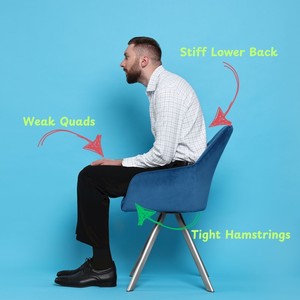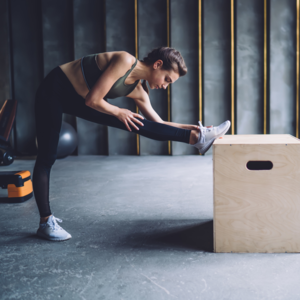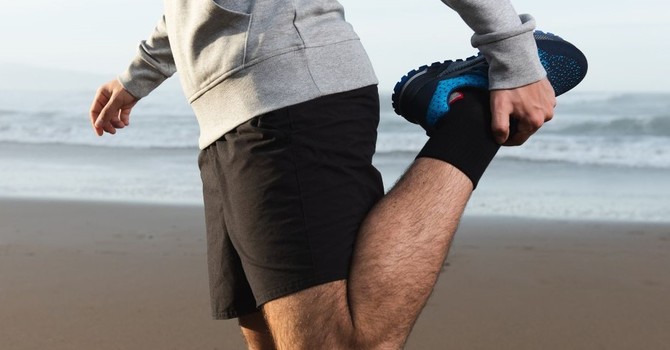.jpg)
The Physical Effects of Desk Work: Understanding the Impact on Your Body
Hours of desk work is a reality for millions of people’s day-to-day routine. While it may seem harmless, sitting at a desk for hours each day can take a toll on your body. Poor ergonomics, prolonged sitting, and repetitive motions contribute to muscle imbalances that lead to chronic pain and discomfort.
In this article we will cover;
- The Common Conditions Caused by Sitting
- The Best Stretches for Relief
- The Best Exercises for Rehabing
- The Best Kind of Specialists To Consider
Please remember, this information is meant to be educational. Sometimes even minor symptoms are signs of something much more serious, so if you are having any concerns or symptoms at all, speak to a healthcare professional before starting any type of treatment or rehabilitation program.
Understanding The Conditions Cause by Sitting
Upper Crossed Syndrome (UCS)

Upper crossed syndrome occurs when there’s a muscular imbalance in the upper body, typically caused by prolonged forward head posture, slouched shoulders rounded forward, and repetitive arm motions.
These habits tighten certain muscles while weakening others, leading to a “crossed” pattern of dysfunction and the appearance of the “neck hump”.
Tight Muscles: Pectorals (chest), upper trapezius, and levator scapulae.
Weak Muscles: Deep neck flexors and lower trapezius/rhomboids.
Symptoms of UCS include:
- Chronic neck pain and stiffness.
- Tension headaches caused by tight muscles at the base of the skull.
- Rounded shoulders and forward head posture.
- Tingling or numbness in the arms due to nerve compression.
Lower Crossed Syndrome (LCS)

Lower crossed syndrome occurs in the lower body and is often the result of prolonged sitting. This condition involves an imbalance between the hip flexors and lower back muscles (which become tight) and the glutes and abdominal muscles (which become weak).
Tight Muscles: Hip flexors, erector spinae (lower back).
Weak Muscles: Glutes and abdominal muscles.
Symptoms of LCS include:
- Lower back pain and stiffness.
- Poor posture with an exaggerated lumbar curve (swayback).
- Weakness in the core and glutes, leading to instability and poor movement mechanics.
- Increased risk of sciatica or other nerve-related issues due to pressure on the lumbar spine.
Together, UCS and LCS create a chain reaction throughout your body, leading to chronic discomfort and an increased risk of injury.
The Long-Term Effects of Desk Work

Prolonged desk work doesn’t just cause muscle imbalances—it can lead to a range of physical issues, including:
1. Chronic Headaches
Tight neck and shoulder muscles from UCS can compress nerves and restrict blood flow, resulting in tension headaches or migraines. These headaches often worsen with stress or prolonged screen time.
2. Poor Posture
Both UCS and LCS contribute to poor posture, including forward head posture, rounded shoulders, and an exaggerated lumbar curve. Over time, poor posture can lead to joint degeneration, pain, and reduced mobility.
3. Nerve Pain
Muscle tightness and imbalances can compress nerves, leading to symptoms like numbness, tingling, or shooting pain in the arms, hands, or legs. This is especially common in individuals with both UCS and LCS.
4. Weak Muscles and Reduced Mobility
When certain muscles are underused, they become weak and less able to support your body. This contributes to reduced mobility, instability, and an increased risk of injury during everyday activities.
Best Stretches for Desk Workers
Incorporating targeted stretches into your daily routine is a great way for short term relief and long term mobility. These stretches help increase mobility, improve flexibility, and support better posture. The first step is understanding which muscles need stretched and which need strengthened. Here are the best stretches for relieving tension and promoting balance:
1. Pectoralis (Chest) Stretch

Why it helps: Tight chest muscles are a hallmark of desk workers, contributing to rounded shoulders and forward head posture. Stretching the pectorals opens the chest and helps realign the shoulders.
How to do it:
- Stand in a doorway and place your hands on the doorframe at shoulder height.
- Step one foot forward and gently lean into the doorway and rotate your body until you feel a stretch across your chest.
- Hold for 20–30 seconds, then relax.
- Repeat 2–3 times.
Pro tip: Adjust the height of your hands to target different parts of the chest muscles.
2. Cervical Flexor Stretch

Why it helps: Tight neck extensors, often overused in UCS, can lead to tension headaches and neck stiffness. This stretch releases tension in the back of the neck while engaging the deep neck flexors.
How to do it:
- Sit with a tall posture.
- Roll up a bath towel and drape it over your shoulders
- Allow your neck to fall back so that the base of your skull rests on the towel.
- Hold for 2-5 minutes. This can be done daily and multiple times per day when needed.
Pro tip: Keep your shoulders relaxed and avoid rounding your upper back during the stretch.
3. Hip Flexor Stretch
.png)
Why it helps: Tight hip flexors, a common feature of LCS, pull the pelvis forward, creating an exaggerated lumbar curve and lower back pain. Stretching these muscles helps restore balance in the pelvis.
How to do it:
- Begin in a kneeling lunge position next to a bench or bed with your left knee bent to 90 degrees and your right foot behind you, supporting your body.
- Shift your weight forward slightly until you feel a stretch in the front of your right hip.
- Now take your back leg and rest it on the edge of the bench/bed while your front foot remains in contact with the ground.
- Hold for 20–30 seconds, then switch sides.
Pro tip: Add a gentle pelvic tilt by tucking your tailbone under for a deeper stretch.
4. Hamstring Stretch

Why it helps: Tight hamstrings, common in LCS, can pull on the pelvis and contribute to lower back pain. Stretching them helps reduce tension and improve flexibility.
How to do it:
- Stand next to a bench, stool or chair. (have something to hold on to if you think you will lose balance)
- Rest one leg on the bench while standing on the other leg.
- Keep your back straight and avoid rounding your spine.
- Bend forward at the hips as if you are bringing your chest to your shin.
- Hold for 30 seconds on each side.
Pro tip: If sitting is uncomfortable, perform this stretch standing by placing one foot on a low surface and leaning forward.
5. Abdominal Stretch

Why it helps: Tight abdominal muscles, often weak and shortened in LCS, can limit spinal mobility and worsen posture. Stretching them promotes better alignment and mobility.
How to do it:
- Lie face down on the floor with your hands under your shoulders.
- Press into your hands and lift your chest off the ground, keeping your hips and legs on the floor.
- Stop when you feel a gentle stretch in your abdominal muscles or if you feel any pain in the lower back.
- Hold for 20–30 seconds, then lower down.
Pro tip:
Keep your shoulders relaxed and avoid overextending your lower back.
By incorporating these stretches into your daily routine, you can help counteract the effects of desk work, improve your posture, and reduce pain. Pair these stretches with strengthening exercises for the best results in addressing upper and lower crossed syndrome.
Best Exercises for Desk Workers
If you spend long hours sitting at a desk, incorporating strength-building exercises into your routine is essential to combat muscle imbalances, improve posture, and reduce pain. Targeted exercises strengthen weak muscles, improve joint stability, and support a healthy alignment. Here are some of the best exercises for desk workers:
1. Rows for the Rhomboids

Why it helps: Rows target the rhomboid muscles in your upper back, which are often weakened by slouched shoulders and forward head posture. Strengthening these muscles helps pull your shoulder blades back into alignment and will help prevent the neck hump later in life.
How to do it:
- Use a resistance band or cable machine.
- Sit or stand with your back straight and your arms extended in front of you, gripping the handles or band.
- Pull your elbows back, squeezing your shoulder blades together at the end of the motion.
- Slowly return to the starting position.
- Perform 2–3 sets of 10–12 repetitions.
Pro tip:
Focus on controlled movements. These types of exercises should always be performed with light weight to allow you to focus on the muscles you are trying to engage.
2. Lat Pulldowns
.png)
Why it helps: Lat pulldowns strengthen the latissimus dorsi, a large muscle in the back that supports your posture and helps stabilize your shoulders.
How to do it:
- Sit at a lat pulldown machine and grip the bar slightly wider than shoulder-width.
- Pull the bar down to your chest, keeping your back straight and your shoulders down.
- Slowly return the bar to the starting position.
- Perform 2–3 sets of 10–12 repetitions.
Pro tip:
Avoid leaning back excessively—keep your core engaged and your movements controlled. LIght weight allows better focus on the muscles you are trying to engage.
3. Reverse Flyes for the Lower Trapezius

Why it helps: Reverse flys target the lower trapezius, which helps stabilize your shoulder blades and counteract the effects of rounded shoulders. You may even find that strengthening the lower portion of your traps relieves the tension typically felt in the upper traps.
How to do it:
- Hold a light resistance band or cable in each hand while standing upright, keeping your back straight.
- With your arms slightly bent, squeezing your shoulder blades together so that your arms move out to your sides (like you are extending your wings).
- Slowly bring your arms back to the starting position.
- Perform 2–3 sets of 10–12 repetitions.
Pro tip:
Use lighter resistance to focus on proper form and avoid straining your neck or shoulders.
4. Back Extensions

Why it helps:
Back extensions strengthen the lower back muscles, which are often weak in desk workers due to prolonged sitting.
How to do it:
- Lie face down on a mat with your hands at your sides or behind your head.
- Lift your upper body off the mat, keeping your neck in line with your spine.
- Focus on using the erector muscles on the sides of your spine. Hold for a moment at the top, then lower back down.
- Perform 2–3 sets of 12–15 repetitions.
Pro tip:
For added resistance, you can perform this exercise on a stability ball or back extension bench.
5. Squats for the Glutes

Why it helps:
Squats strengthen the glutes, which are often underactive in desk workers, helping to stabilize the pelvis and reduce lower back strain.
How to do it:
- Stand with your feet shoulder-width apart.
- Lower your body as if sitting into a chair, keeping your chest upright and your knees aligned with your toes.
- Push through your heels to return to standing.
- Perform 2–3 sets of 10–12 repetitions.
Pro tip: Focus on engaging your glutes at the top of the movement for maximum benefit.
6. Leg Extensions for the Quads

Why it helps: Leg extensions target the quadriceps, which help support the knees and reduce strain on the lower body during prolonged sitting. Remember, sitting all day stretches the quadriceps, this exercises can directly counteract the effects of sitting.
How to do it:
- Sit on a leg extension machine with your legs bent and feet under the padded bar.
- Extend your legs until they are straight, but don’t lock your knees.
- Slowly lower back to the starting position.
- Perform 2–3 sets of 12–15 repetitions.
Pro tip: Use a moderate weight and focus on controlled movements to avoid putting unnecessary stress on your knees.
Putting It All Together
Incorporate these exercises into your weekly routine to strengthen key muscles, improve posture, and reduce the negative physical effects of desk work. Aim to perform these exercises 2–3 times per week, either at the gym or at home with the appropriate equipment.
Once you no longer feel the symptoms of desk work, these exercises can be performed at little as once per week to maintain your progress. By combining these strength-building exercises with stretches and ergonomic adjustments, you can keep your body balanced, reduce discomfort, and maintain a healthy posture despite the demands of desk work.
Best Therapies for Desk Workers
To counteract the physical effects of prolonged desk work, a comprehensive approach is often the most effective. Combining chiropractic care, exercise therapy, and massage therapy can address postural imbalances, reduce pain, and restore proper function. Let’s dive into how each of these therapies can help.
1. Chiropractic Care: Realign and Restore

Chiropractic care is a cornerstone therapy for addressing the postural imbalances caused by desk work. Misalignments in the spine, particularly in the cervical and lumbar regions, can lead to chronic pain, nerve irritation, and muscle tension.
How chiropractic care helps desk workers:
- Realigns the spine: Adjustments help restore proper alignment, reducing pressure on nerves and improving overall posture.
- Relieves tension: By correcting misalignments, chiropractic care reduces strain on muscles and joints caused by poor posture.
- Improves mobility: Restores range of motion in the neck, shoulders, and lower back, making it easier to maintain good posture throughout the day.
A chiropractor can also provide personalized ergonomic advice, helping you set up your workspace to prevent future issues.
2. Exercise Therapy: Strengthen and Stabilize

Exercise therapy focuses on strengthening weak muscles and stretching tight ones to correct the imbalances caused by upper crossed syndrome (UCS) and lower crossed syndrome (LCS).
A customized exercise program tailored to your needs can significantly improve your posture and reduce pain.
Key benefits of exercise therapy:
- Builds strength: Exercises targeting the core, glutes, and back muscles provide stability and support for the spine.
- Improves flexibility: Stretching tight muscles like the chest, hip flexors, and hamstrings helps counteract the effects of prolonged sitting.
Promotes balance: Correcting muscular imbalances improves overall posture and reduces the risk of injuries.
Working with a chiropractor or physical therapist ensures you’re performing the right exercises with proper form, maximizing the benefits while minimizing the risk of strain or injury.
3. Massage Therapy: Relax and Rejuvenate

Massage therapy is an excellent complement to chiropractic and exercise therapy, especially for desk workers dealing with tight, overused muscles. Regular massages can relieve tension, improve circulation, and promote relaxation.
How massage therapy benefits desk workers:
- Releases muscle tension: Focused massage techniques target tight areas like the neck, shoulders, and lower back, reducing discomfort and improving mobility.
- Enhances circulation: Increased blood flow delivers oxygen and nutrients to the muscles, supporting faster recovery.
- Reduces stress: Massage therapy promotes relaxation, helping to relieve stress that often exacerbates pain and tension.Techniques like deep tissue massage and trigger point therapy are particularly effective for addressing the chronic tension caused by desk work.
The Power of a Combined Approach
Using these therapies together offers a holistic approach to treating the physical effects of desk work. Chiropractic adjustments address alignment issues, exercise therapy strengthens and stabilizes key muscle groups, and massage therapy provides relief from tension and stress.
The Importance of Proper Posture for Joint Alignment and Muscle Health
Good posture is more than just standing tall—it’s the foundation for a healthy musculoskeletal system. When your posture is properly aligned, it allows your joints, muscles, and spine to function optimally. This not only helps prevent pain and discomfort but also reduces the risk of long-term joint degeneration and muscle strain.
The bottom line is, if your problems originated from poor posture at the desk, you will never truly fix them without correcting your posture.
Why Proper Posture Matters
Maintains Joint Alignment: When your body is in proper alignment, your joints sit in their intended positions, minimizing unnecessary wear and tear. Misaligned joints caused by poor posture can lead to premature degeneration, such as arthritis, and increase the risk of injuries.
Allows Muscles to Relax: Poor posture forces certain muscles to work harder than they should, leading to chronic tension and fatigue. For example, forward head posture strains the neck and upper back muscles, while slouched shoulders overwork the chest and upper traps. Proper posture redistributes the workload evenly across your muscles, allowing them to relax and recover.
Prevents Degeneration (The Neck Hump!): Over time, poor posture accelerates the breakdown of joints and tissues. By maintaining proper alignment, you reduce stress on your spine and other joints, preventing the chronic issues that can develop from years of sitting or standing improperly.
How to Improve and Maintain Proper Posture
- Be Mindful of Your Alignment: Keep your ears aligned with your shoulders and your shoulders aligned with your hips, whether sitting or standing.
- Use Ergonomics: Ensure your workspace promotes a neutral spine position, with your monitor at eye level and your chair supporting your lumbar curve.
- Strengthen Supporting Muscles: Exercises that strengthen the core, glutes, and upper back help maintain good posture throughout the day.
- Take Breaks: Regularly stand, stretch, and move to prevent stiffness and keep your muscles engaged.
Pro tip: routinely get up for a drink of water - hydration plays a vital role in physical health and this is a great way to combat a sedentary lifestyle and hydration issues.
Let Green Space Health Help You Align and Thrive
If you found this article helpful and would like to work with us, schedule your appointment today and take the first step toward better posture, less pain, and a healthier you. Call or book online now, and let’s work together to realign your body and restore your balance!
Check Availability Today

Dr. Mike Sebastian
Contact Me



